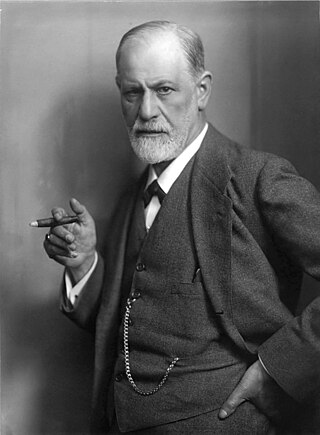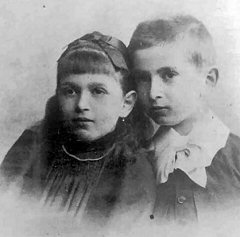
Sigmund Freud was an Austrian neurologist and the founder of psychoanalysis, a clinical method for evaluating and treating pathologies seen as originating from conflicts in the psyche, through dialogue between patient and psychoanalyst, and the distinctive theory of mind and human agency derived from it.
In psychoanalysis and other psychological theories, the unconscious mind is the part of the psyche that is not available to introspection. Although these processes exist beneath the surface of conscious awareness, they are thought to exert an effect on conscious thought processes and behavior. Empirical evidence suggests that unconscious phenomena include repressed feelings and desires, memories, automatic skills, subliminal perceptions, and automatic reactions. The term was coined by the 18th-century German Romantic philosopher Friedrich Schelling and later introduced into English by the poet and essayist Samuel Taylor Coleridge.

Dream interpretation is the process of assigning meaning to dreams.
Psychoanalytic literary criticism is literary criticism or literary theory that, in method, concept, or form, is influenced by the tradition of psychoanalysis begun by Sigmund Freud.
"Rat Man" was the nickname given by Sigmund Freud to a patient whose "case history" was published as Bemerkungen über einen Fall von Zwangsneurose ["Notes Upon a Case of Obsessional Neurosis"] (1909). This was the second of six case histories that Freud published and the first in which he claimed that the patient had been cured by psychoanalysis.
Psychoanalytic theory is the theory of personality organization and the dynamics of personality development relating to the practice of psychoanalysis, a clinical method for treating psychopathology. First laid out by Sigmund Freud in the late 19th century, psychoanalytic theory has undergone many refinements since his work. The psychoanalytic theory came to full prominence in the last third of the twentieth century as part of the flow of critical discourse regarding psychological treatments after the 1960s, long after Freud's death in 1939. Freud had ceased his analysis of the brain and his physiological studies and shifted his focus to the study of the psyche, and on treatment using free association and the phenomena of transference. His study emphasized the recognition of childhood events that could influence the mental functioning of adults. His examination of the genetic and then the developmental aspects gave the psychoanalytic theory its characteristics.

Emma Eckstein (1865–1924) was an Austrian author. She was "one of Sigmund Freud's most important patients and, for a short period of time around 1897, became a psychoanalyst herself". She has been described as "the first woman analyst", who became "both colleague and patient" for Freud. As analyst, while working mainly in the area of sexual and social hygiene, she also explored how 'daydreams, those "parasitic plants", invaded the life of young girls'.

The Interpretation of Dreams is an 1899 book by Sigmund Freud, the founder of psychoanalysis, in which the author introduces his theory of the unconscious with respect to dream interpretation, and discusses what would later become the theory of the Oedipus complex. Freud revised the book at least eight times and, in the third edition, added an extensive section which treated dream symbolism very literally, following the influence of Wilhelm Stekel. Freud said of this work, "Insight such as this falls to one's lot but once in a lifetime."
A dream dictionary is a tool made for interpreting images in a dream. Dream dictionaries tend to include specific images which are attached to specific interpretations. However, dream dictionaries are generally not considered scientifically viable by those within the psychology community.

Sergei Konstantinovitch Pankejeff was a Russian aristocrat from Odesa, Russian Empire. Pankejeff is best known for being a patient of Sigmund Freud, who gave him the pseudonym of Wolf Man to protect his identity, after a dream Pankejeff had of a tree full of white wolves.
Dreamwork is the exploration of the images and emotions that a dream presents and evokes. It differs from classical dream interpretation in that it does not attempt to establish a unique meaning for the dream. In this way the dream remains "alive" whereas if it has been assigned a specific meaning, it is "finished". Dreamworkers take the position that a dream may have a variety of meanings depending on the levels that are being explored.

Dora is the pseudonym given by Sigmund Freud to a patient whom he diagnosed with hysteria, and treated for about eleven weeks in 1900. Her most manifest hysterical symptom was aphonia, or loss of voice. The patient's real name was Ida Bauer (1882–1945); her brother Otto Bauer was a leading member of the Austro-Marxist movement.
Psychoanalytic dream interpretation is a subdivision of dream interpretation as well as a subdivision of psychoanalysis pioneered by Sigmund Freud in the early 20th century. Psychoanalytic dream interpretation is the process of explaining the meaning of the way the unconscious thoughts and emotions are processed in the mind during sleep.
Max Schur was a physician and friend of Sigmund Freud. He assisted Freud in euthanasia. Ernest Jones considered that "Schur was a perfect choice for a doctor... his considerateness, his untiring patience, and his resourcefulness were unsurpassable".
Paul Federn was an Austrian-American psychologist who was a native of Vienna. Federn is largely remembered for his theories involving ego psychology and therapeutic treatment of psychosis.
Daseinsanalysis is an existentialist approach to psychoanalysis. It was first developed by Ludwig Binswanger in the 1920s under the concept of "phenomenological anthropology". After the publication of "Basic Forms and Perception of Human Dasein", Binswanger would refer to his approach as Daseinsanalysis. Binswanger's approach was heavily influenced by the German philosopher Martin Heidegger and psychoanalysis founder Sigmund Freud. The philosophy of daseinsanalysis is centered on the thought that the human Dasein is open to any and all experience, and that the phenomenological world is experienced freely in an undistorted way. This way initially being absent from meaning, is the basis for analysis. This theory goes opposite to dualism in the way that it proposes no gap between the human mind and measurable matter. Subjects are taught to think in the terms of being alone with oneself and grasping concepts of personhood, mortality and the dilemma or paradox of living in relationship with other humans while being ultimately alone with oneself. Binswanger believed that all mental issues stemmed from the dilemma of living with other humans and being ultimately alone.

Louis Breger was an American psychologist, psychotherapist and scholar. He was Emeritus Professor of Psychoanalytic Studies at the California Institute of Technology
Content in Freudian dream analysis refers to two closely connected aspects of the dream: the manifest content, and the latent content. Impulses and drives residing in the unconscious press toward consciousness during sleep, but are only able to evade the censorship mechanism of repression by associating themselves with words, ideas and images that are acceptable to consciousness. Thus the dream as consciously remembered upon waking is interpreted in psychoanalysis as a disguised or distorted representation of repressed desires.

Wish fulfillment is the satisfaction of a desire through an involuntary thought process. It can occur in dreams or in daydreams, in the symptoms of neurosis, or in the hallucinations of psychosis. This satisfaction is often indirect and requires interpretation to recognize.

Sigmund Freud is considered to be the founder of the psychodynamic approach to psychology, which looks to unconscious drives to explain human behavior. Freud believed that the mind is responsible for both conscious and unconscious decisions that it makes on the basis of psychological drives. The id, ego, and super-ego are three aspects of the mind Freud believed to comprise a person's personality. Freud believed people are "simply actors in the drama of [their] own minds, pushed by desire, pulled by coincidence. Underneath the surface, our personalities represent the power struggle going on deep within us".







